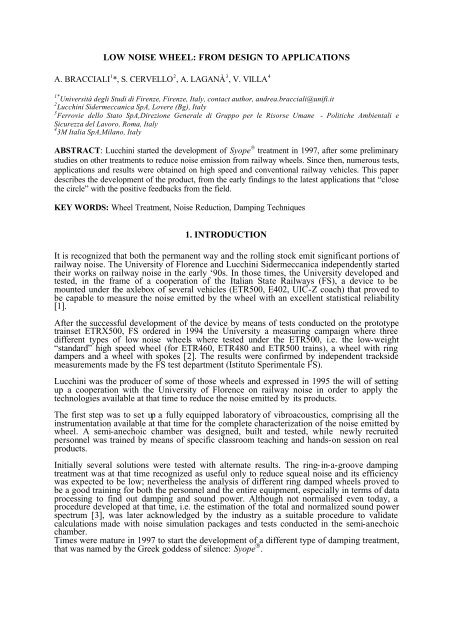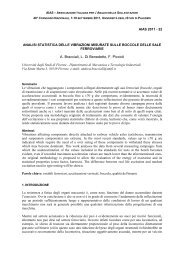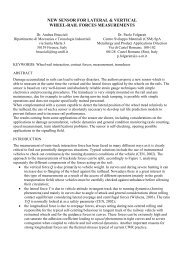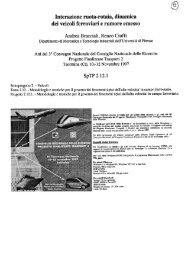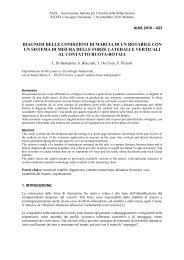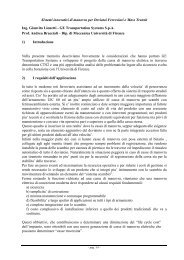LOW NOISE WHEEL - Home page Andrea Bracciali
LOW NOISE WHEEL - Home page Andrea Bracciali
LOW NOISE WHEEL - Home page Andrea Bracciali
You also want an ePaper? Increase the reach of your titles
YUMPU automatically turns print PDFs into web optimized ePapers that Google loves.
<strong>LOW</strong> <strong>NOISE</strong> <strong>WHEEL</strong>: FROM DESIGN TO APPLICATIONSA. BRACCIALI 1 *, S. CERVELLO 2 , A. LAGANÀ 3 , V. VILLA 41* Università degli Studi di Firenze, Firenze, Italy, contact author, andrea.bracciali@unifi.it2 Lucchini Sidermeccanica SpA, Lovere (Bg), Italy3 Ferrovie dello Stato SpA,Direzione Generale di Gruppo per le Risorse Umane - Politiche Ambientali eSicurezza del Lavoro, Roma, Italy4 3M Italia SpA,Milano, ItalyABSTRACT: Lucchini started the development of Syope ® treatment in 1997, after some preliminarystudies on other treatments to reduce noise emission from railway wheels. Since then, numerous tests,applications and results were obtained on high speed and conventional railway vehicles. This paperdescribes the development of the product, from the early findings to the latest applications that “closethe circle” with the positive feedbacks from the field.KEY WORDS: Wheel Treatment, Noise Reduction, Damping Techniques1. INTRODUCTIONIt is recognized that both the permanent way and the rolling stock emit significant portions ofrailway noise. The University of Florence and Lucchini Sidermeccanica independently startedtheir works on railway noise in the early ‘90s. In those times, the University developed andtested, in the frame of a cooperation of the Italian State Railways (FS), a device to bemounted under the axlebox of several vehicles (ETR500, E402, UIC-Z coach) that proved tobe capable to measure the noise emitted by the wheel with an excellent statistical reliability[1].After the successful development of the device by means of tests conducted on the prototypetrainset ETRX500, FS ordered in 1994 the University a measuring campaign where threedifferent types of low noise wheels where tested under the ETR500, i.e. the low-weight“standard” high speed wheel (for ETR460, ETR480 and ETR500 trains), a wheel with ringdampers and a wheel with spokes [2]. The results were confirmed by independent tracksidemeasurements made by the FS test department (Istituto Sperimentale FS).Lucchini was the producer of some of those wheels and expressed in 1995 the will of settingup a cooperation with the University of Florence on railway noise in order to apply thetechnologies available at that time to reduce the noise emitted by its products.The first step was to set up a fully equipped laboratory of vibroacoustics, comprising all theinstrumentation available at that time for the complete characterization of the noise emitted bywheel. A semi-anechoic chamber was designed, built and tested, while newly recruitedpersonnel was trained by means of specific classroom teaching and hands-on session on realproducts.Initially several solutions were tested with alternate results. The ring-in-a-groove dampingtreatment was at that time recognized as useful only to reduce squeal noise and its efficiencywas expected to be low; nevertheless the analysis of different ring damped wheels proved tobe a good training for both the personnel and the entire equipment, especially in terms of dataprocessing to find out damping and sound power. Although not normalised even today, aprocedure developed at that time, i.e. the estimation of the total and normalized sound powerspectrum [3], was later acknowledged by the industry as a suitable procedure to validatecalculations made with noise simulation packages and tests conducted in the semi-anechoicchamber.Times were mature in 1997 to start the development of a different type of damping treatment,that was named by the Greek goddess of silence: Syope ® .
2. THE Syope TREATMENT2.1 IntroductionWheel damping can be obtained in several ways, which will not be discussed here. From theliterature it was known at that time that both the track and the vehicle emit significant part ofrolling noise and that the wheel-rail contact patch is able to supply a so-called “rollingdamping” which must be largely exceeded to get a significant reduction of the noise emittedby the wheel.Similarly, as the wheel is only one the components producing noise, the overall noise will bedecreased only by the relevant portion [4]. This makes the use of wheel damping particularlypromising only where track has an intrinsically low-noise formation, and especially at highfrequency and at high speed, where simulations indicated that wheel was the dominant soundradiator.Lucchini identified the well-known constrained layer damping solution as the only feasible as:• the treatment was expected to be automatically approximately equally effective on allwheel eigenmodes, while other treatments need to be ‘tuned’ on the specific wheeleigenmodes. Similarly, the treatment was expected to be relatively independent from thewheel tyre thickness modification after reprofiling, that significantly changes wheelmodes (see a later paper, [5], for a proof of this statement);• the treatment is self-centring and radial centrifugal forces are supported by the metallicpanel and not by polymer, virtually eliminating any stress during the service;• it was expected to possibly apply the treatment to any axial symmetric wheel withoutmodifications to the current geometry, virtually without changing the design and applyingthe treatment to replacement wheel;• the peculiarities of the treatment let suppose that no structural modifications wereintroduced in the wheel and that no safety analysis would have been necessary to beperformed on the treated wheel.At the same time, Lucchini was aware that:• it was necessary to find out a polymer with extremely good properties, considering theexpectations in terms of lifetime in service of a wheel (up to five years) and the extremelydemanding conditions of the railway environment;• the only possible mounting of the wheels on the axle is the press fit one, while shrink (hot)fit normally in use in Italy was not possible as the polymer could not survive to the 200-250° C heating;• the treatment is only possible for disc-braked wheelsets as block braking introduces toomuch heat in the wheel tread that is transferred to the wheel web damaging the polymer.All of these problems were carefully considered and Lucchini started the development of theSyope ® treatment initially as a premium solution for high speed trains. Only after many yearsthe market would have appreciated the product as a valid solution for ordinary service and forlight railways.2.2 Description of the Syope treatmentBasically, the treatment consists of a steel layer constraining a special adhesive polymersheet. The polymer was developed by 3M for aerospace applications and was selected after acareful evaluation of mechanical, chemical and physical properties. Such a polymer based onacrylate technologies has several important features that gave many industrial applications thepossibility to solve not only sound reduction but also bonding aspects and sealing needs.The polymer has a special structure completely homogeneous in every part, this structure hasduring the application process micro movements that fill all the microprofile of the materialsinvolved with a strong improvement in performances also just after a few minutes from theapplication. This aspect can solve also many of the problems due to thermal differentials,especially when the materials bonded together are not the same and then are affected bydifferent contraction or expansion; this is one of the reason of choice in aerospaceapplications where the thermal variation is wide and fast.
The product does not contain volatile or corrosive components so the surface covered with thepolymer does not suffer absolutely any chemical corrosion also along the years. Splash testsconducted in U.S. certify good resistance when the join along the thickness is cleaned withthe normal industrial cleaning products.Nevertheless being the product a “solid glue” it has been possible to cut the polymer in thecorrect shape without the problem of perimetral adhesive excess and does not require specialattention during deliveries and during the joint life.2.3 Laboratory Vibroacoustics TestsAlthough the validation of the damping treatment in terms of reduction of response vibrationamplitude at the resonance were quite easy to be assessed, the efficacy in reducing the noiseemitted by the wheel needed a different method to be proven. As for all sound measurement, afree field with a low background noise was needed. These conditions are not easily found inindustrial plants, and Lucchini and University of Florence cooperated to design asemianechoic chamber that was finally certified as compliant with the international standardson sound power emission [6].The normalized sound power emitted at each natural frequency was determined by using thealready mentioned procedure. It consists of collecting the output of an array of microphonesmounted on an arc centred at the wheel centre, with the wheel resting on a “soft” support andgiving an impact with an instrumented hammer. Ensuring that the highest natural rigidfrequency of the wheel on its support is lower than 1/3 of the lowest elastic mode of the wheelresults in the so-called “free-free” response of the wheel, i.e. the impact gives an initial speedto the excitation point but the wheel is then free to vibrate without both other excitation andconstraints. As the floor is reflecting, the entire sound energy is measured by themicrophones.The output from all the microphones is properly added to estimate the power output from thehemispherical surface defined by the rotation of the array around the wheel axis. Usingreciprocity theorem, the arc of microphones was kept standing while the impact point wasmoved around the circumference. The total power was normalized with the excitation,resulting in the estimation of reduction of noise from the wheel in service (Figure 1).Figure 1. The semianechoic chamber in Lovere with the arc array of microphones (left).Normalized sound power levels obtained in 1997 for the Italian Railways high speed wheel(monobloc, curved web, d=890 mm) with steel and aluminum constraining plate.Reductions obtained at each frequency with steel plate are shown (right).These data were considered very promising but were believed to be only partially reachable inpractice for the already mentioned existence of “rolling damping”. Thanks to a cooperationwith Fiat Ferroviaria, it was therefore planned a set of line tests with the test trainset ETR470-0.
3. 1997: HIGH SPEED TESTS WITH ETR470-0 TRAINSETETR470-0 is a tilting train of the Pendolino family that Fiat Ferroviaria was using at that timeas a test train to develop different technologies. Lucchini supplied 4 wheelsets with Syope ®treatment with steel constraining plates. Test runs up to 250 km/h were performed and noiseemission was measured with conventional standing microphones and with a linear array ofmicrophones in order to horizontally separate the sources (Figure 2).Figure 2. Left to right: experimental Syope ® wheels on the ETR470-0 trainset, tracksidemicrophones during a 250 km/h pass-by, preparation of linear array of microphones.A pass by at 220 km/h is shown in Figure 3; the presence of an additional source, installed todevelop a computer program able to remove the Doppler effect and to identify the wheels,emitting noise at exactly 2 kHz is evident near the front driver’s cab. Noise reduction during apass-by at 220 km/h is shown in Figure 4. Although it is evident that the exceptional resultsobtained in the laboratory tests were not reached, the around 5 dB(A) reduction wasconsidered very promising and the results were presented to FS on 13 May 1999.Figure 3. Left to right: time-frequency analysis (spectrogram) average on 21 microphones,analysis of a standard wheelset and analysis of a Syope ® wheelset.Figure 4. One-third octave band and overall noise levels measured during a pass-by at 220km/h of the ETR470-0 trainset. Data for untreated (red) and Syope ® treated (green) wheels.
4. QUALITY ASSURANCE CONSIDERATIONSAs the activity on Syope ® wheels was progressing fast, it was decided in 1999 that all furtheractivities had to be conducted in the respect of quality assurance rules. Lucchini developedfour technical specifications [7,8,9,10] to standardize the supply of the polymer, of the steelsheet and of the complete screen. Also the mounting process was adequately described.At the end of 1999, the Technical Report on the Syope Project [11] virtually closed theexperimental phase opening the industrial application phase of the product.5. 2000: HIGH SPEED TESTS WITH A ETR500 PLT TRAINSET5.1 IntroductionAfter the results obtained with the ETR470-0 trainset, the newborn FS Trenitalia UnitàTecnologie Materiale Rotabile (UTRM, Rolling Stock Technology Unit) decided for a moreextensive and precise noise measuring campaign. At that time a trilateral cooperation of themain European Railways (DB, FS, SNCF) was setting up a high speed campaign in the threecountries to investigate the aerodynamic drag at high speed and the influence of bogie fairingsto reduce energy consumption of high speed trains.Times were mature to test Syope ® wheel on the new multivoltage ETR500 PLT trainsetnumber 51, and Trenitalia contacted the University of Florence to perform on-board andtrackside noise measurements on his behalf. A great advantage was resulting from the factthat also technicians from DB were in charge of measuring trackside noise with a spiral arrayof microphones that was able to efficiently separate the sources in both vertical and lateraldirections.The train was prepared in order to solve one of the main limitation of the ETR470-0campaign, i.e. the different roughness of the standard and Syope ® wheels. Most of the wheels(approx. 75%) were reprofiled at a time in Milano Fiorenza workshop, and tests on the Roma-Firenze Direttissima line started two weeks after, when the train had run approximately 3000km. Incidentally, this is the same distance that will be recommended by [12] around five yearslater.The coincidence of the aerodynamic drag test campaign allowed the test of all thecombinations of the following parameters:• speed, in the range 195-300 km/h;• fairings (with special acoustic treatment);• Syope ® wheels;• reprofiling.5.2 ResultsThe results were processed and published independently by Trenitalia - University ofFlorence [13] and by DB measuring group [14] and can be summarized as follows: in the190÷295 km/h range, the use of Syope ® treatment reduces the noise by 4 to 5 dB(A), offeringsimilar or better performances compared to fairings. Speed confirmed its importance whileturning the wheels reduced by approximately 2 dB(A) the noise emitted by standard wheels.The advantage offered by Syope ® wheels is better at the lower limit of the speed range tested,as fairings are particularly efficient at the higher speeds where aeroacoustics noise becomesprevailing.The train composition and the typical noise “signature” from the pass-by are shown in Figure5, while photographs and results are shown in Figure 6 and in Figure 7.
Pass-by direction1 2 3 4 5 6 7 81 2 3 4 5 6 7 8 9Florenceturn turn turn + turn + turn +acoustic Syope + Syopefairings acousticfairingsturnArezzoStandard wheels “as they are” Standard wheels turned Syope wheels turnedFigure 5: Composition of the test ETR500PLT-51 trainset (left) during the test campaignin Renacci, 2000 (left). The typical noise signature (L pAmax,F ) at 7.5 m of a pass-by isshown on the right, where the effect of wheel reprofiling and Syope ® wheels is evident.Figure 6: Some images from the test campaign in Renacci, 2000, on the ETR500 PLTtrainset 51. Left: train passing by in front of the spiral array of microphones by DB; mid:axlebox noise measuring device developed by University of Florence in front of a Syope ®wheel; right: classical standing microphone at d=7.5m, h=1.2 m from the track centerline.10095Syope+ shroudsSyopeStandard+ shroudsStandardSPL dB(A)90858075190 235 260 295Speed km/hFigure 7: Noise emission comparison between standard and Syope ® wheels, found by (left)University of Florence - Trenitalia and by (right) DB.After the completion of the test campaign, it was decided by Trenitalia UTMR to leave thewheelsets in service. A first check was done on 18 February 2002 at Milano Fiorenza depot,after approximately 200.000 km, and it was found that no damages were visible on the Syope ®panels. It is worth to note that the coach number 7 in the experiments (90 83 5 889 200-2,Bar-Dining Car, one bogie with Syope ® wheels) had in the meantime become part ofETR500PLT-31 and was therefore not inspected.6. 2000: <strong>LOW</strong> SPEED TESTS ON A NARROW GAUGE LIGHT RAILWAYWhile all the tests shown up to now were conducted on high speed train, LucchiniSidermeccanica was facing also the problem of noise reduction at lower speeds. This task iseven more challenging, as it was known and accepted that at low speed the track becomes thedominant source and that remedies taken on the wheel can be of low or none effect.Lucchini supplied Syope ® wheels for two different type of trains of Circumvesuviana, a localnarrow gauge (950 mm) light railway with a very intense traffic situated in Naples area. The
network, 140 km long, crosses densely populated areas where the disturbance induced bynoise can be significant.Extensive test campaigns were done in the 50-90 km/h range, showing a reduction of theoverall rolling noise of 4 to 5 dB(A) also in this lower speed range, without any modificationsto the track [15].A special problem that affects most of the trains of Circumvesuviana is, moreover, squealnoise in some narrow curve close to a couple of luxury hotels whose customers were stronglycomplaining about high level tonal noise especially at early morning. Although it isrecognized that squeal noise is an erratic phenomenon, that often appears and disappearswithout a specific and clearly identifiable reason, it was not observed anymore during passbysof the trains equipped with Syope ® wheels (see Figure 8).Figure 8: A Circumvesuviana EMU train ETR200 negotiating a narrow curve close toPorta Nolana terminus station, just below a luxury hotel, where squealing is common (left).Noise spectra of ordinary (“Norm.”) ETR200 compared to another trainset equipped withSyope ® (right)7. SAFETY CERTIFICATION BY ITALCERTIFERIt is evident that any modification applied to a wheel may compromise safety. Immediatelyafter the decision of performing tests, Lucchini submitted to Italcertifer, the Italian body forrailway certification, all the technical documentation about the project, including theaforementioned reports and technical instructions.Italcertifer, with the support of Trenitalia UTMR, evaluated the test results and the documentsand, also on the basis of service checks, released on 28 August 2002 the evaluation of themechanical and acoustical properties of the Syope ® treatment [16].The most important conclusions that were reached can be listed as follows:• “The Syope treatment does not require any geometrical or structural modifications to thewheels on which it is applied. The mounting of panels… does not require furthermechanical mounting systems… as a consequence, it does not alter the resistanceproperties of the wheel and has no structural functions (therefore it is not subjected toexternal loads…)”• “Mechanical and adhesive properties of Syope treatment… have been verified with laband in-field tests following the reference standards.”• “The manufacturing and mounting process is defined by supply procedures and materialchecks, mounting procedures and final check procedures. These procedures allow to traceall the manufacturing and check phases of the Syope treatment.”• “Moreover, the wheel production process with Syope treatment differs from the standardwheel solely for the panel mounting phase”• “We certify that trackside noise measurements reveal a noise emission reduction of Syopetreated wheels compared to standard wheels. For the microphone placed at 7.5 m from theline centreline, such reduction is not lower that 4 dBA in the speed range 200 to 300km/h… the emission reduction is particularly concentrated in the frequency range above 1kHz.”
• “Since December 2000 FS Trenitalia uses 16 wheels with Syope treatment on twoETR500 trainsets used for both tests and commercial service. We certify that thesetrainsets have been used up to 320 km/h and that up to now they have run approximately300.000 km without any problem due to the Syope treatment”.8. APPLICATION CASESLucchini presented at Innotrans 2002 in Berlin the results of the laboratory and line testsalready mentioned. At that time, the reconstruction process of the Merano-Malles line, alongthe Venosta valley on the Alps near the Austrian border, was at an advanced stage. The line,formerly managed by Italian State Railways FS, was closed in the early ‘90s as it wasconsidered not productive. The Autonomous Province of Bolzano decided to re-activate theline and was searching for a low environmental impact rolling stock. They finally chose aDMU articulated train manufactured by Stadler, Switzerland, that incorporates many state-ofthe-artsolutions. People in charge asked Lucchini to supply wheels with Syope ® treatment,and the line was finally opened on 5 May 2005 and immediately got a great success, graduallyalmost replacing the coach services along the valley.The train has the structure shown in Figure 9 and is capable of running at speed up to 100km/h. Trailing bogies are quite conventional and are equipped with Syope ® wheels (discbrakes on the axle), while the central motor car has brakes mounted on the wheel web, asolution that intrinsically offers a low noise. For new rolling stock of this kind (DMU), Italianlaws [17] require a maximum L pA,F of 83 dB(A) after 1/1/2002 and 81 dB(A) after 1/1/2012measured at 80 km/h with the microphone at 25 m from the track centreline (height=3.5 m).Figure 9: Stadler GTW 2/6 of Val Venosta regional railway.Tests were conducted on 12/13 July 2005 on a line section with a very limited slope ofapproximately 2‰, a condition that allowed measurement with full throttle climbing up toMalles and with engines off descending down to Merano. It was therefore possible to evaluatethe contribution of rolling noise to overall noise at full power.The highest maximum level of noise of 79.0 dB(A) was recorded during a 100 km/h fullpower run, while the noise at 80 km/h with both the engines off was stable around 74.0 dB(A)[18]. These values are much lower than what is currently requested by Italian law and willsatisfy also the requirements of 2012; moreover, the rolling noise contribution to the overallnoise is particularly limited (9 dB(A) less than 2002 limit, 5 dB(A) less than overall noise)and contributes only slightly to the noise pollution.Once again, what is satisfactory is the result obtained by a low speed regional train. It is worthto note that these results were obtained on a track with a roughness spectrum largely abovelimits stated by EN ISO 3095:2005.Another noticeable application was the supply of high speed trainsets of the “Pendolino” typeto Czech Railways. In 2000 Fiat Ferroviaria undertook an order of construction for ten tiltingtrains, but their number was then reduced to seven; the first set was delivered in 2004 asPendolino CD 680 (Figure 10). While testing from Breclav to Brno on November 18, 2004,the Pendolino reached a speed of 237 km/h and created a new Czech railway speed record.Since 2006 the service was extended to Slovakia and Austria.
Figure 10. A Czech 680 Pendolino.These trains are very similar to the prototype Pendolino ETR470 and the wheels were exactlythe same; although no noise measurements were performed by Lucchini or by the Universityof Florence, there is no reason to forecast different results from those obtained during the testsin Italy. The Czech application is anyway noticeable as adverse environmental conditionsbrought to the light a feature that was not possible to observe in Italy, i.e. a high number offreezing and thawing out cycles that repeatedly allowed water to turn to ice and back leadingto partial detachment of panels. This inconvenient generated a sealing procedure that wasapplied since then in all the subsequent wheels supply.In 2005 Circumvesuviana decided to adopt the Syope ® wheel as the retrofit standard for theentire existing fleet and for the new trains that are object of a tender. This is by far the largestsingle order of Syope wheels until now (totalling approximately more than 3000 wheels) andis particularly interesting as the Railway Administration will change the entire maintenanceoperation procedure (passing from shrink fit to press fit) with the inevitably associated coststhat are anyway lower than those linked to the use of noise barriers.More recently, the Train Operating Companies Trenitalia SpA (part of the Italian StateRailways, Holding FS SpA) and Cisalpino AG ordered a new tilting train named ETR600 (12trainsets) and ETR610 (14 trainsets) respectively and emitted a so stringent tender that themanufacturer (Alstom Ferroviaria) had to include the Syope ® damping treatment.This step is crucial as the European Directives assign to the Infrastructure Owner (RFI inItaly) the responsibility for noise pollution disturbance. The use of noise reduction measuresat the source is therefore a noticeable example that fulfils the same legislation that states thenoise reduction measures should be adopted preferably at the source and then on the acousticpath (leaving the measures on the receiver as the last option).The first trains are currently undergoing homologation tests and no data are available from thenoise emission point of view; a thorough investigation is planned in Autumn 2007 and theresults will be presented at the next WCRR2008 conference in Seoul [19]. It is worth notingthat the wheel changed radically from that used in the previous versions of Pendolino, and thiswill very likely lead to further improvements in noise emission reduction.Figure 11. The Cisalpino ETR610-001 during a transfer run (13.06.2007)
9. PANEL STRENGTH AT THE END OF <strong>WHEEL</strong> LIFE9.1 Syope ® wheel recovery at the end of their lifeAlthough external loads on the panel are mainly centrifugal and are supported by themechanical structure of the panel (whose elasticity modulus is much greater than that of thepolymer) and by the constraints given by the shape of the wheel web, some concernsremained about the effective durability of the treatment in real service.Of the whole set of wheels installed in 2000 under ETR500 PLT-51, four wheelsets, i.e. thosemounted on 1 st Business Class Coach #6 (number 90 83 5 899 207-5, both bogies with Syope ®wheels), finished their life under ETR500 PLT-56, were returned to Lucchini plant in Lovereand were treated as normal steel scrap.Thanks to the cooperation with the Maintenance structure of Trenitalia, it was instead possibleto monitor the status of other four wheels, i.e. those mounted on 1st Class Coach #7 (number90 83 5 199 212-2, one bogie with Syope ® wheels). These wheels where collected at theTrenitalia Workshop in Vicenza at the end of July 2005 at the end of their useful life, i.e1.100.000 km and five years after they were mounted in 2000.Once again, Trenitalia recognized [20] that the use of Syope ® wheels had been absolutely“transparent” to the final user, also on a high value train that was regularly inspected: “Aboutmaintenance aspects, the life cycle of mentioned wheelsets was absolutely identical to that ofall the other wheelsets used on ETR500 trains…”. Nevertheless, an overview of the panelconditions in the workshop showed that external panels had some parts that were apparentlydetached. It was decided to keep the wheels back to Lucchini Sidermeccanica laboratories inLovere to verify, after a full life, the final conditions of the constraining panel.9.2 Panel tear tests at the end of wheel lifeAs the external action on panel is due to the combination of the centrifugal force and verticalvibrations (peak and random) induced by actual wheel rolling on actual rail, it is readilyunderstood that these actions can never produce a detach of the panel. It was thereforenecessary to “invent” a test procedure that had no resemblance with reality trying to tear offthe panel from the wheel web. Several decisions were taken:- the external action should have been able to detach the panel from the wheel, i.e. it hadto be applied along the wheel axis;- no mechanical action was permitted on the panel before the external action is applied,i.e. it is not possible to make bores, threads or other fixing surfaces;- no thermal loads had to be applied on the panel, i.e. any welding to the panel isforbidden.The only possibility left was to bond a disk on the inner border of the panel, where the surfaceis minimum and hence the possibility of detaching the panel is maximum. A structural gluewas chosen and two rings, one for the internal panel and one for the external panel, wereprepared. The rings were rigid enough to avoid deformation during tension tests and werepulled by a statically determinate system of chains and rings. The system is shown in Figure12 and in Figure 13.Figure 12. Tear test preparation. Left: the glue is applied to the internal ring. Mid: curingtime was min. 24 hours. Right: Universal traction machine with Syope wheel mountedready for tear test.
Figure 13. Results of tear test on the internal panel (the ring detached at 51 kN withoutdetaching the panel, above) and on the external panel (the ring detached at 21 kN withoutdetaching the panel, below)From these tests it was concluded that the reserve of safety was still largely sufficient and thatfive years of service of the prototypes were not sufficient to reduce the adhesion properties ofthe polymer. As a result, safety is absolutely guaranteed in any railway application.10. CONCLUSIONS AND FURTHER DEVELOPMENTSSyope ® treatment underwent a decade development, including all the aspects of research,development and industrial processes. As a result, it proved to be a safe and reliable noisereduction treatment that preserves its functionality for the full life of the wheel.Although technical aspects are certainly a prerequisite for any wheel related product, recentfindings show that also Life Cycle Cost analyses [21] are favourable, highlighting how theimpact of this measure is advantageous compared to noise barriers.The blending of advantageous technical and economical issues are the reason for thecontinuously increasing success of the Syope ® product.Italian State Railways FS policy not only forecasts the use of noise barriers installed by RFI(infrastructure owner) but starts introducing the concept that also mass produced trains for themain train operator Trenitalia can be effectively equipped with noise reduction devices thatcan avoid the use of noise barriers in “border” noise pollution situations. This is a major leaptowards the total and combined approach towards the reduction of railway noise, that can bereached only through the deep cooperation of all the actors involved.Following the commitment to always provide the market with technologically advanced andsafe products, Lucchini Sidermeccanica is currently developing, with the continuous supportof the University of Florence and of its main customers, other solutions for tread brakedwheels [22] and for wheels with discs mounted on the web [23].11. REFERENCES[1] BRACCIALI, A., CIUFFI, L., CIUFFI, R., RISSONE, P.: Continuous External TrainNoise Measurements through an On-board Device, Journal of Rail and Rapid Transit208, 1994, 23-31.[2] BRACCIALI, A., CIUFFI, L., CIUFFI, R.: Calibration of an On-Board NoiseMeasuring Device by Simultaneous Measurement of Trackside Noise of Three Different
Wheelsets for the ETR500 F.S. Train, Journal of Rail and Rapid Transit 211, 1997, 41-49.[3] CERVELLO, S., BRACCIALI, A.: Development of a Vibro-Acoustical Methodologyfor the Design of Low Noise Railway Wheels, Proceedings of the World Congress onRailway Research WCRR1997, Firenze, September 1997, vol. E, pp. 157-163[4] THOMPSON, D. J.: Wheel-rail noise generation, parts 1÷5, Journal of Sound andVibration, 161(3), 1993, 384-482.[5] CATALDI-SPINOLA, E., GLOCKER, C., STEFANELLI, R., GÖTSCH, M.: Influenceof the Wheel Diameter on the Curve Squealing of Railway Vehicles, Proceedings ofEuronoise 2003, Naples, paper ID 465 (on CD).[6] ISO 3744: Acoustics - Determination of sound power levels of noise sources usingsound pressure - Engineering method in an essentially free field over a reflecting plane,1994.[7] LUCCHINI SIDERMECCANICA SpA, CRS/IT_L02/11: Istruzione tecnica per lafornitura di lamine in acciaio "P04" per la produzione di ruote Syope, 1999[8] LUCCHINI SIDERMECCANICA SpA, CRS/IT_L02/12: Istruzione tecnica per lafornitura di nastro biadesivo 3M XXX XXXX/XXXX, 1999[9] LUCCHINI SIDERMECCANICA SpA, CRS/IT_L02/13: Istruzione tecnica per lafornitura di pannelli Syope, 1999[10] LUCCHINI SIDERMECCANICA SpA, CRS/IT_L02/14: Istruzione tecnica per ilmontaggio di pannelli Syope su ruote monoblocco, 1999[11] LUCCHINI SIDERMECCANICA SpA CRS/IT_L02/10: Relazione Tecnica RuotaSyope, 1999[12] INTERNATIONAL ORGANIZATION FOR STANDARDIZATION, ISO 3095:2005Railway applications - Acoustics - Measurement of noise emitted by railbound vehicles[13] BRACCIALI, A., BIANCHI, M.: Lucchini CRS Syope® damped wheels noisequalification”, Proceedings of the 13th International Wheelset Congress, Roma, 2001.[14] DEGEN, K. G., NORDBORG, A., MARTENS, A., WEDEMANN, J.,WILLENBRINK, L., BIANCHI, M., “Spiral Array Measurements Of High-Speed TrainNoise”, Proceedings of Internoise 2001, Den Haag.[15] BORRELLI, A., CERVELLO, S.: Syope ® . La nuova ruota ferroviaria a ridottaemissione acustica sviluppata e prodotta da Lucchini Sidermeccanica, IngegneriaFerroviaria, vol 5, pp. 463-473 (2003).[16] ITALCERTIFER: Relazione tecnica per ruota Syope, Prot. 140, 28.08.2002[17] DECRETO DEL PRESIDENTE DELLA REPUBBLICA n° 459 DEL 18/11/1998,Regolamento recante norme di esecuzione dell'articolo 11 della legge 26 ottobre 1995,n. 447, in materia di inquinamento acustico derivante da traffico ferroviario.[18] BRACCIALI, A., CERVELLO, S., MORODER, H., Qualificazione acustica dei trenidella Val Venosta, Proc. of the Institution of Italian Railway Engineers (CIFI)conference on “Reconstruction of Val Venosta Railway”, Firenze, 2006.[19] BRACCIALI, .A, CERVELLO, S., MANZI, N.,GUERDER, J.Y., CORBIZIFATTORI, A., LAGANÀ, A., FIRMI, P.: Characterization of the rolling noise emittedby ETR600 Trenitalia train following International and European InteroperabilityRegulations, Submitted for presentation at the WCRR 2008 Conference, Seoul.[20] TRENITALIA, LUCCHINI, UNIVERSITA’ DI FIRENZE: Verbale di visita ruoteETR500 Syope ® montate su sale US 9326257 e US 9352436, Vicenza, 27.7.2005[21] BRACCIALI, A., CERVELLO, S., GATTI, P.: Acoustic effectiveness of damped wheelsand impact on life-cycle cost of different typologies of passenger trains, Proceedings ofthe 9 th International Workshop on Railway Noise, Munich, 2007
[22] BRACCIALI, A.: Low Noise Wheels: Lucchini Solutions. International WorkshopRailway noise in urban areas: possible source noise reduction measures. Pisa, 9-10November 2006[23] BRACCIALI, A., CERVELLO, S., MORODER, H.: Application of noise reductionsystems to wheels with web-mounted discs. Submitted for presentation at the WCRR2008 Conference, Seoul.


